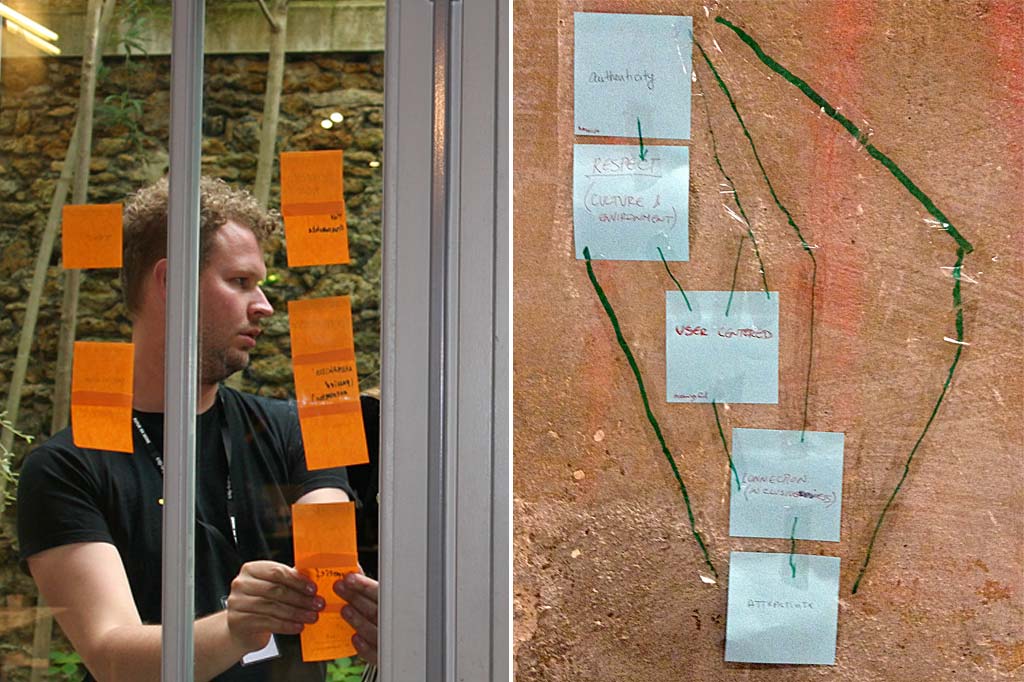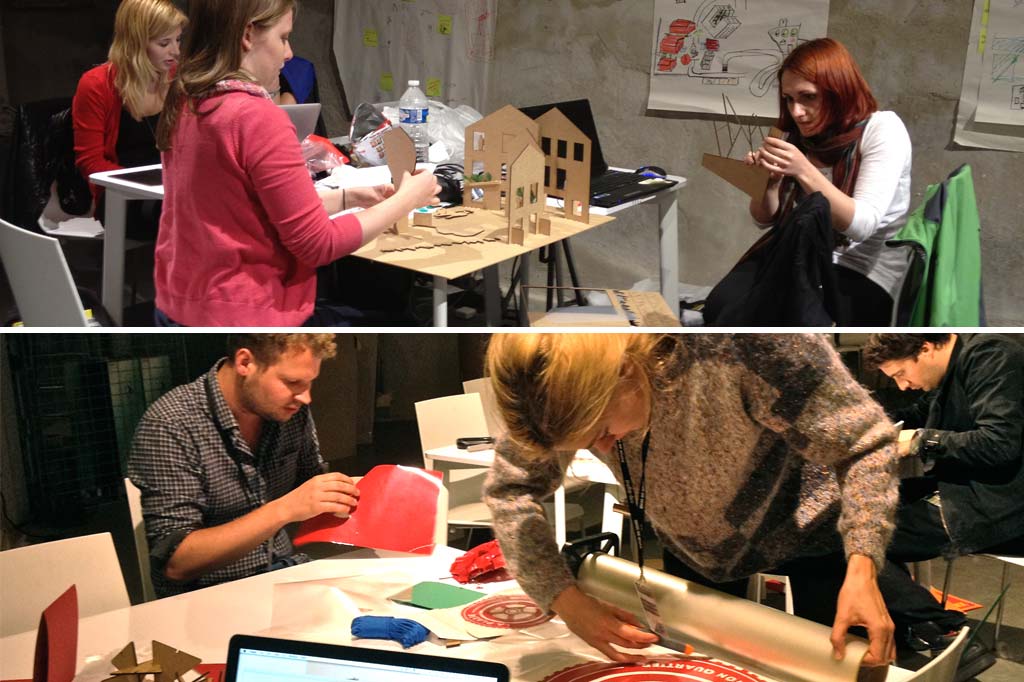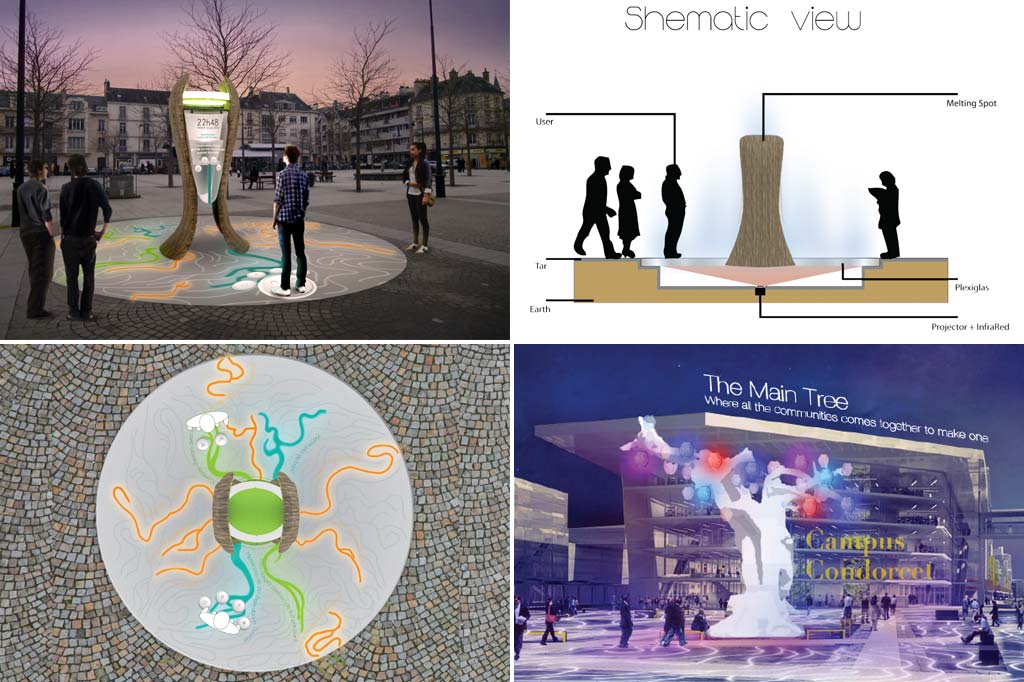Aim
In 2016, the Campus de Condorcet, the largest university centre for the Humanities in Europe, will open its doors for students and researchers in Saint-Denis La Plaine. The aim of the 2012 European Design Challenge was to connect the highly diverse urban community around the planned new Condorcet Campus on a digital and physical level in order to promote “civicism”, citizen participation, civic and cultural awareness, shared responsibility, entrepreneurship and sustainability.
Specific issues for the Challenge in this area included:
- Integration of local creative industries into the community as an inspirational, regenerative and unifying factor
- Citizen participation in community and creative development – “civicism”, shared identity, responsibility, ownership and entrepreneurship
- Cross-cultural information and creativity exchange on the basis of a shared and open physical and virtual platform
- Optimum integration of innovative transport resources
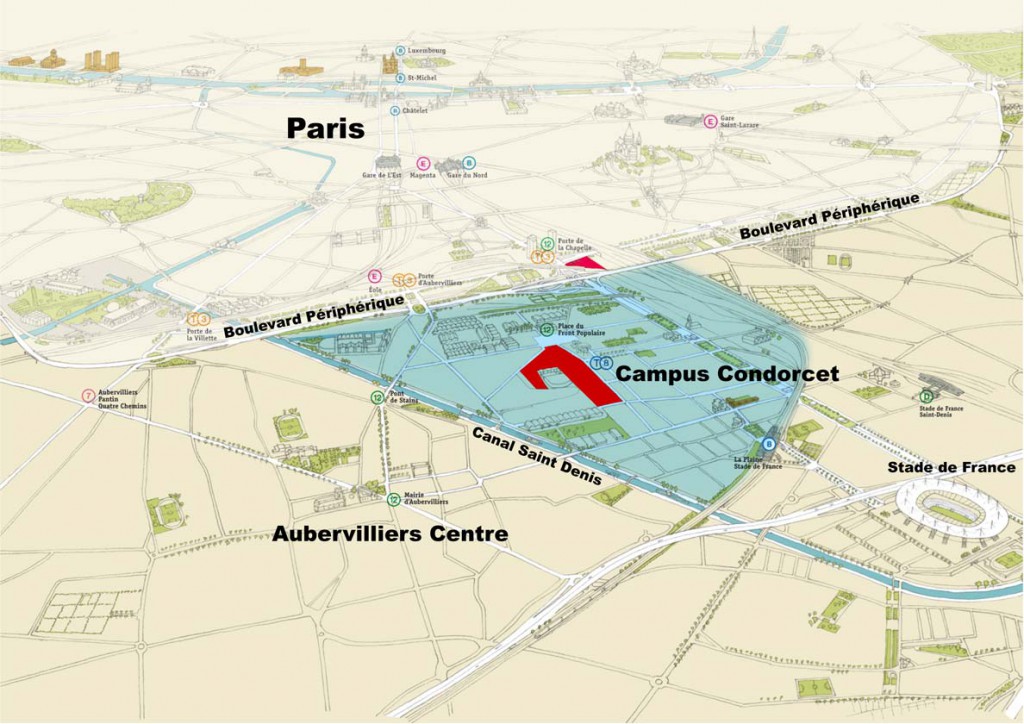 The position of Campus Condorcet in Saint-Denis La Plaine
The position of Campus Condorcet in Saint-Denis La Plaine
Design proposition
At present, this area represents a striking, colourful, dense and complex mixture of cultures (e.g traditional working-class French, Chinese, Indian and Romany), industries (e.g. goods storage, Asiatic wholesale trade, high-tech, film and TV studios and production, new digital creative industries) and architectural styles (e.g. pre-war and post-modern residential, industrial warehouses and factories, wholesale and retail “barracks”, research centres). This is very much a critical phase of transition and development: derelict factory space, a myriad of wholesale and retail outlets, travellers camps, social and provide housing stand side-by-side with ambitious new development projects for the university.
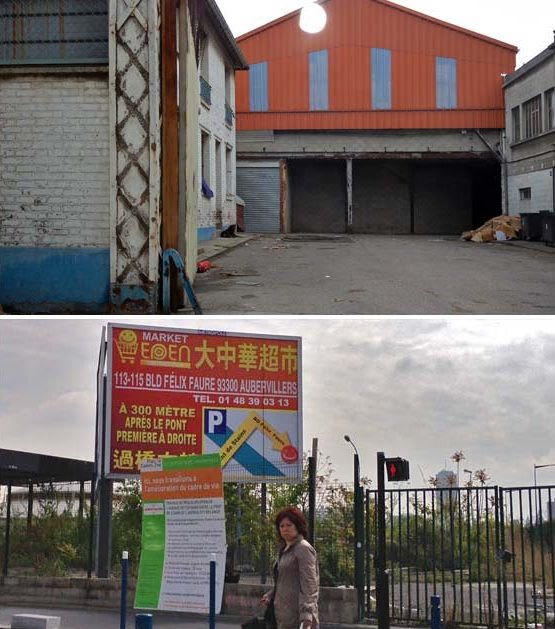
The strong character and identity of Seine-Saint-Denis La Plaine has been formed by its rich heritage of multi-cultural endeavor around creative, commercial and industrial development – from the immigrant community of “Petite Espagne”, who came to work in the area during the industrial boom years of the late 19th and 20th centuries, to the rapidly growing Chinese community now developing around the consumer wholesale trade.
This urban complexity of the Saint-Denis La Plaine area raises a multitude of real Challenges, for example:
- design meaningful connectivity across multi-cultural, multi-functional diversity
- maintain one’s own traditional identity while sharing a new, common identity
- provide an infrastructure and transport system with adequate connection facilities
- provide green “breathing spaces” and recreational facilities and informal public spaces for such a dense area.
- allow adequate participation of all players and residents for the “organic” creation of a new social space
It would indeed be a real design challenge to create an area around the new Condorcet Campus, and particularly the Place du Front Populaire, which connects and integrates communities, while allowing them to maintain their identity, alongside a new university and research centre, and the film studios of the new creative industries – a cultural meeting point, centre of work and leisure, and participative creativity which adequately expresses the history and future of the area, a space where workers, residents, and visitors feel both inspired and “at home”.
 Place “Front populaire” with its two metro entrances is still under contruction
Place “Front populaire” with its two metro entrances is still under contruction
Selection of the teams
In this third edition of the European Street Design Challenge, a broader selection of international and regional teams of creative SMEs, start-ups and students was made in line with the conviction that increased international perspective heightens the innovation potential.
As in previous Challenges, the participants were selected using the following criteria:
- Authentic thinker – strong sense of identity as a creative, ability to connect content and context to real solutions
- Excellent design skills – on an esthetic and technical level
- High ability to work under pressure – making decisions, going for the most optimum result in a short time frame
- High ability to work in a group – flexible, willingness to share knowledge, understanding of group dynamics/qualities versus individual dynamic/quality
The following teams entered the ESDC in 2012:
- London University of the Arts and Design, UK
- Ravensbourne College, London, UK
- Team Eindhoven – Young professionals from Eindhoven, NL
- Kunsthochschule, Linz, A
- TKK Design College, Xiamen, CN
- Strate School of Design, Paris, FR
- Ecole Boulle, Paris FR
Preperations for the Challenge
As ever, the Challenge demanded detailed preparation around the target area for redesign in Saint Denis La Plaine. Also as last year, we were very fortunate to have been supported generously by the Department of Seine-Saine-Denis, and particularly Ouafae Benslimane, Ph.D – Chef de projet recherche, innovation Conseil général de la Seine-Saint-Denis, Direction de l’Aménagement et du Développement.
Ouafae and her team accompanied us on visits to the site in La Plaine, provided knowledge about the local history of the area, and made the necessary connections to facilitate our work.
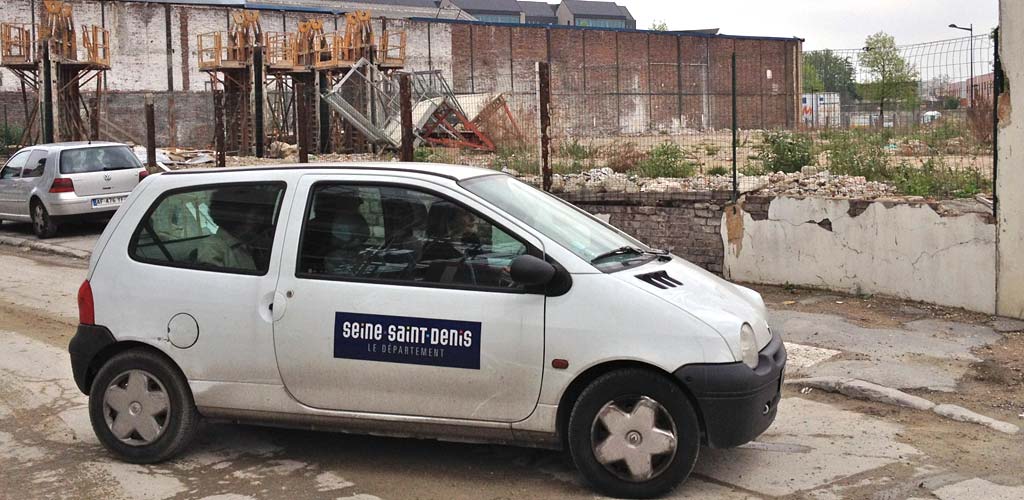 The ESDC team’s first visit to the area, with Ouafae Benslimane and Anne Descos
The ESDC team’s first visit to the area, with Ouafae Benslimane and Anne Descos
The Condorcet site in La Plaine was visited several times in the months before the Challenge, in order fully to understand the topology of the area, particularly from perspectives of social history, demography and architecture.
On the afternoon of 12th June, the day before the start of the Challenge, the seven teams met at the CentQuatre Arts Centre for a briefing to prepare them for the coming days.
Process – Day 1
The Challenge started on the first day of the Futur en Seine festival on Thursday, 13th June, at the CentQuatre, Center of Arts and Culture. At 10am, the Challenge presentation was the first event on the “Scène Live” stage. In front of the international teams, and other members of the audience who were interested in the Challenge, Andrew Bullen presented the history of the event, and the aims of the present Challenge, focusing on the Saint-Denis La Pleine area.
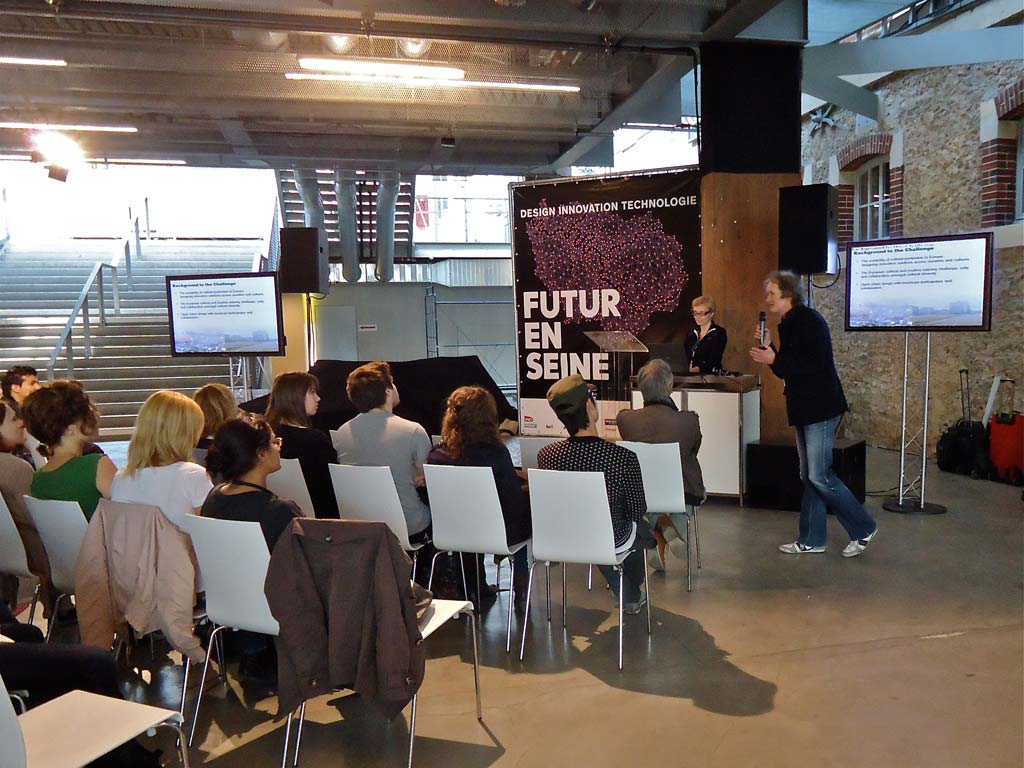 Andrew Bullen and Janine Huizenga welcome all contestants and officially open the ESDC 2012
Andrew Bullen and Janine Huizenga welcome all contestants and officially open the ESDC 2012
Visiting Saint-Denis La Plaine / Campus Condorcet
Immediately after the presentation, all the participants (27 young designers from around the world) left the CentQuatre on foot to visit the targeted redesign area in Saint-Denis La Plaine / Condorcet area. They were accompanied by the Challenge organisers, Anne from the Conseil Général Seine-Saint-Denis, and Bernard Orantin, a local resident and keen historian of the area.
The Saint-Denis La Plaine area was approached from a new and particularly interesting perspective: via the navette on the Canal de Saint-Denis, which gives access to the new Millenaire Shopping Centre.
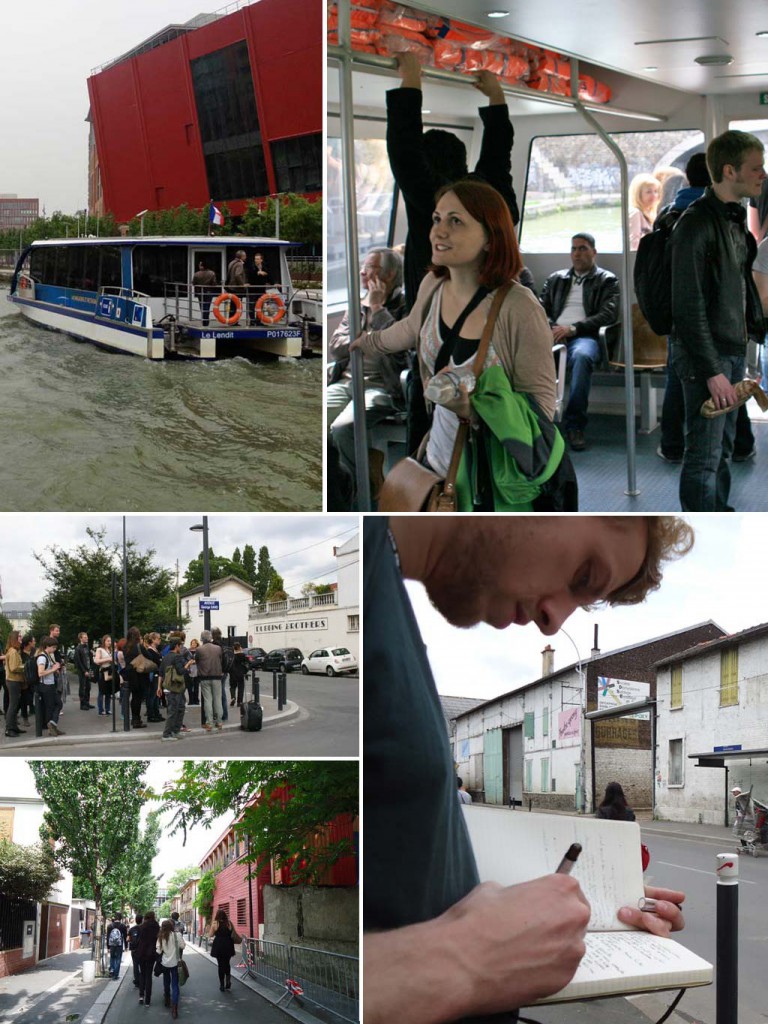 The teams visit the area with local guide Bernard Orantin
The teams visit the area with local guide Bernard Orantin
There followed a quite exhausting three hour tour of the La Plaine area on foot: from the new film studios and creative industries in the warehouses of the EMGP area, though the building site around the future Place du Front Populaire, past the new Museum of the Science of Man in the rue des Fillettes, through the old factory area to the north of the Condorcet Campus, and passing through the old Spanish settlement, before returning to the Millenaire via the Canal St. Denis and the Chinese wholesale quartier. Bernard Orantin provided an excellent overview of the social history of the area (and was sometimes joined by local residents or workers), and key points along the way.
At the end of the tour, the participants returned to the CentQuatre to begin the brainstorming exercises, starting with Emotional Mapping.
1. Emotion Mapping
Participants were asked to make an emotion map containing all observations regarding emotions experienced while walking through the area. These observations were of a subjective nature, sensorial impressions like smell, sound, feelings of discomfort, happiness, etc. They first had to make their own, personal emotion map before the whole team had to get together to fuse all these separate maps into one, sharing an emotion map of the experience.
Participants then repeated the exercise, on a team basis, but this time they focused on reconstructing the architectural topology of the area from memory. This exercise reveals the physical points which the participants experienced as “key landmarks” in the area.
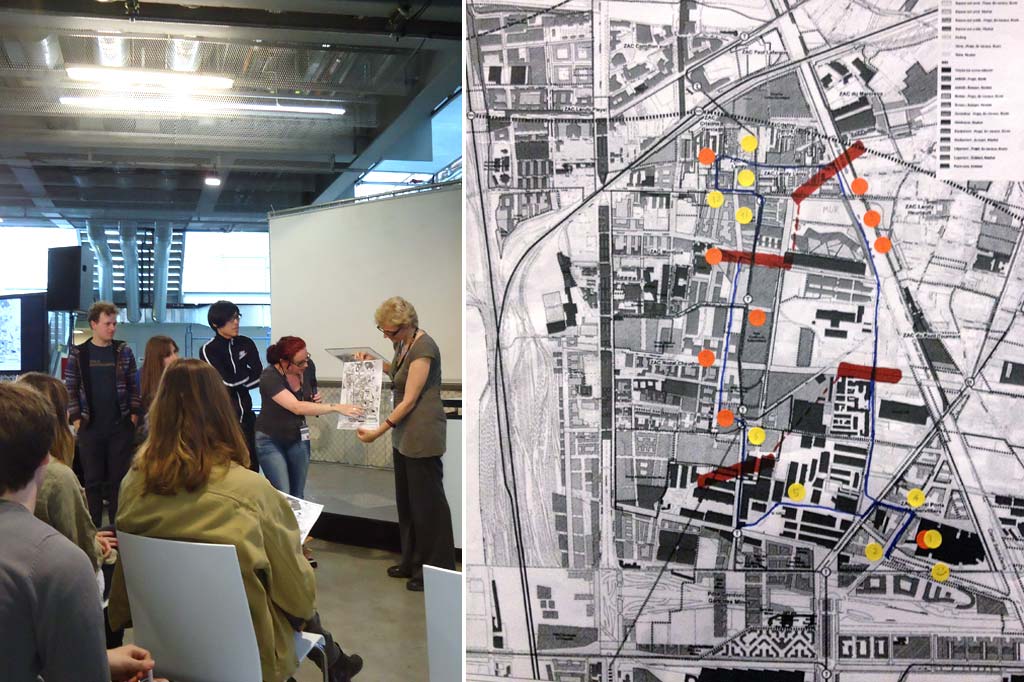 The teams present their Emotion maps to each other
The teams present their Emotion maps to each other
2. Memory Mapping
Participants then repeated the exercise, on a team basis, but this time they focused on reconstructing the architectural topology of the area from memory. This exercise reveals the physical points which the participants experienced as “key landmarks” in the area.
 Ravensbourne and Xiamen University Art College present their final Memory maps to the group
Ravensbourne and Xiamen University Art College present their final Memory maps to the group
3. Value Ladder
The participants were asked to define a set of five values that are important to him/her as a human being and as a designer, particularly in relation to the area which he/she is about to redesign. Starting with each participant having 5 core values, discussion then starts until all individual values are “filtered down” to only five values that are understood and accepted by the whole group. These values will be revisited by the teams throughout the challenge. They serve as a touch stone for their designs and they will have to be reflected in the final designs.
Among others, the following values were defined :
1) Respect (Ravensbourne)
2) Humour (Ecole Boulle)
3) Shadow – « The other side » (Eindhoven young designers)
4) Sensory (University of the Arts London)
5) Unity (Strate School of Design)
6) Aesthetically engaging (Xiamen University Art College)
7) Trust (University of the Arts Linz)
Before leaving at the end of a long, hard first day, the teams were given the assignment of preparing an Appreciative Inquiry for presentation the next morning.
Process – Day 2
The teams started the second day with an Appreciative Inquiry, an exercise made famous by David Cooperider. In this exercise, the teams explore and narrate experiences, places or events which have inspired them most and which can be applied to their present design task.
Following are a selection of inspirational moments or places narrated by the teams:
1) Greenwich University (Ravensbourne)
2) Mirroir d’Eau (Ecole Boulle)
3) Bijlmertientje (Eindhoven young designers)
4) Madrid Home for Nomads (University of the Arts London)
5) Camden Town (Strate School of Design)
6) Hakka Building (Xiamen University Art College)
7) Alte Saline Hallein (Linz)
After the appreciative inquiry, the teams continued the concept creation, design and build process of their prototype models and presentations. Discussion and feedback is essential for the iterative development procession, and the Challenge organisers were expertly supported by Fiona van de Geijn, FabLab specialist, and Nancy Ottaviano, architect and Phd researcher, in the creative process.
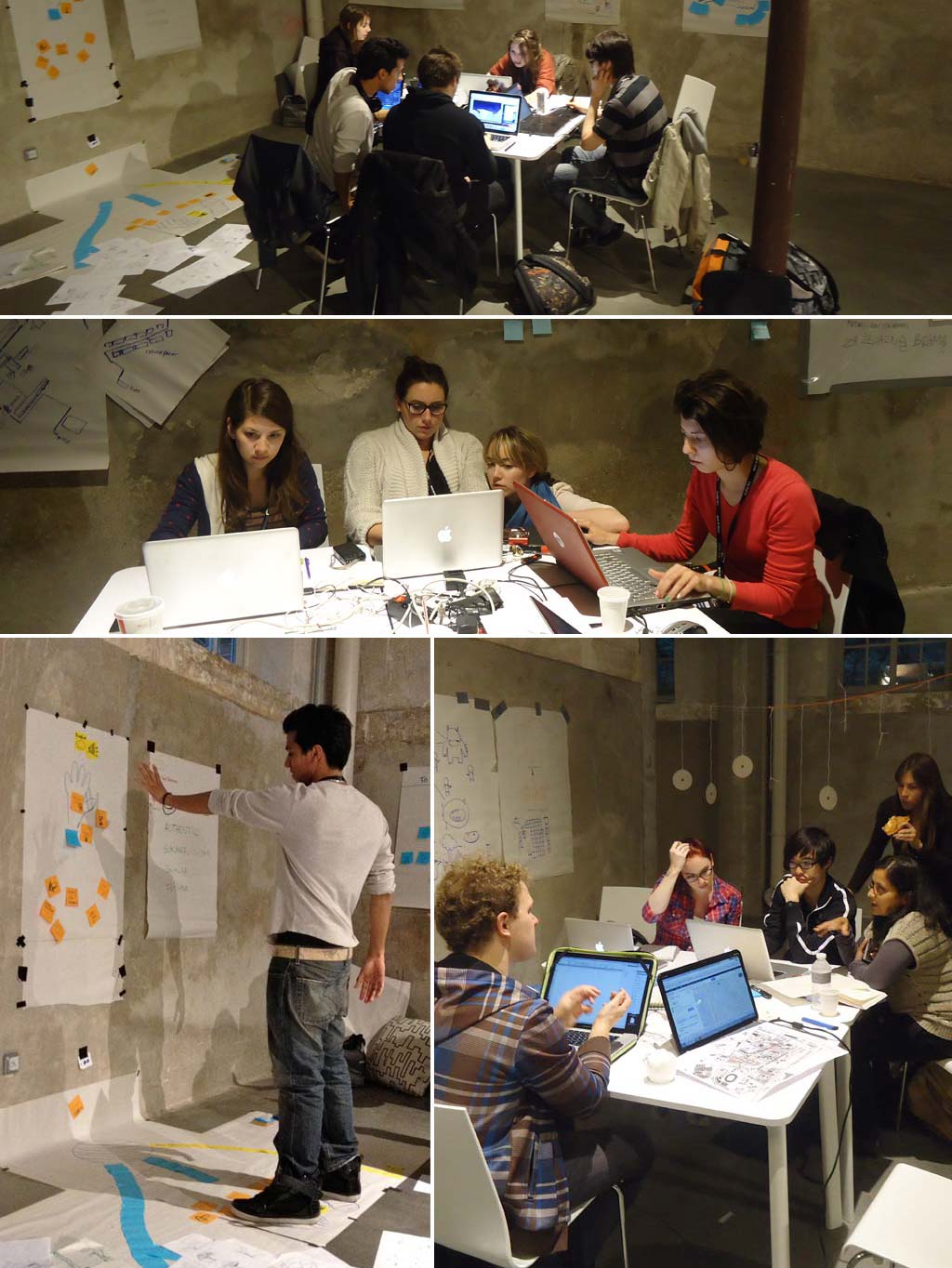 Brainstorming and paper prototyping
Brainstorming and paper prototyping
During the whole of the development process, participants had free use of the Nod-a Fab lab, situated directly next to the Challenge ateliers.
At the end of the second day, the Challenge participants reluctantly left the CentQuatre at 10pm; most would have prefered to work through the night in the ateliers. In the event, many of the teams continued working through the night in the hotel or at home.
The Process – Day 3
On the morning of the third and last day all teams worked hard to finish their prototypes and presentations. At 14:00, the jury visited all the teams to get to know their projects in greater depth. At 16:00, the final presentation and award event began in Salle 200.
ESDC 2012 Jury
The 2012 Challenge was fortunate to have an excellent jury of invited specialists from the Creative Industries, Design and Research:
- Jean-Louis Frechin – internationally renowned designer, teacher and Creative Director of Futur en Seine, 2012
- Philippe David – Project Leader, Research and Development, SNCF, France
- Pascal Deseure – Director, European Business Development, Crystal, CG, China
- Hélène Triboulet Director, Cerfav Glass Factory, Pantin
- Elodie Bongrain Head of Design, faberNovel, Paris
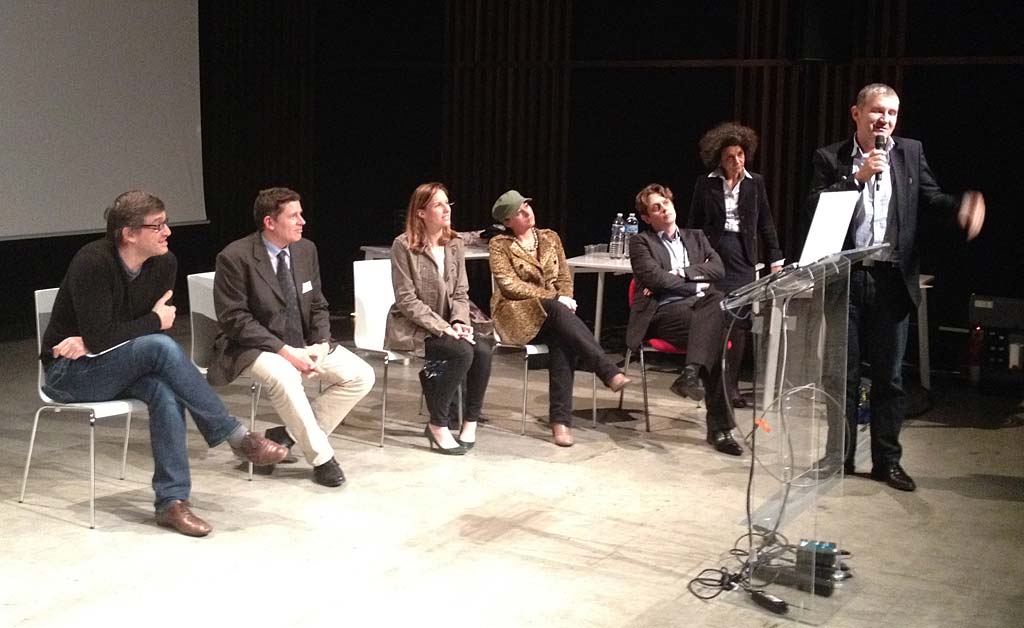 The ESDC jury and Conseil General S-S-D representatives: (from left to right) Pascale Deseure, Phillipe David, Elodie Bongrain, Hélène Triboulet, Henri Verdier, Ouafae Benslimane, Jean-Louis Frechin
The ESDC jury and Conseil General S-S-D representatives: (from left to right) Pascale Deseure, Phillipe David, Elodie Bongrain, Hélène Triboulet, Henri Verdier, Ouafae Benslimane, Jean-Louis Frechin
Andrew Bullen moderated as the teams presented the following solutions:
 1)Andrew Bullen 2)Young Professionals Eindhoven NL 3)London University for the Arts UK 4)Linz University for the Arts AUT 5)Xiamen University Art College CN 6)Ecole Boulle FR 7)Ravensbourne UK 8)Strate School of Design FR
1)Andrew Bullen 2)Young Professionals Eindhoven NL 3)London University for the Arts UK 4)Linz University for the Arts AUT 5)Xiamen University Art College CN 6)Ecole Boulle FR 7)Ravensbourne UK 8)Strate School of Design FR
“Melting Spot” – Team Strate School of Design, Paris
Paul Miles Idrobo-Castro, Nicolas Fallourd, Cyril Zhao, Claire Paoletti, Sandra Scalisi
Design proposition:
With Melting Spot, Strate School of Design proposed a networked system of questions, information and messages to bring the communities of Saint-Denis La Plaine together. At the centre of this system are local communications “totems”. The various totems are connected through a vast network of roots linking into the “hub” at the University, with a central totem at the Place du Front Populaire. Users can interact with the totems through foot and hand movement and a multi-lingual speech recognition service to feed questions or information into the system. These messages can be viewed throughout the system, and also visualized as colour-coded groups. In this sense, the totems and network serve as an interactive “melting spot” for the ideas and questions of the community.
The visualization of the “roots” of the system can also be carried further into the Metro system. Indeed, the whole communications network is also scalable to link other communities and networks.
“Melodie Plaine Saint Denis” – Team University of the Arts, London
Melissa Dupre, Jenna Edgar, Marek Kultys, Yi Ju Tsai
Design proposition:
The project proposes rediscovering the community through the creation of soundscapes by local school kids, together with their parents and local creative industries.
Kids form the basis for this proposed project as they will inherit the area, represent the future multi-cultural community, and indeed know no boundaries as regards their friends at school.
Local school children would be set the task of creating soundscapes of their culture – e.g. Chinese, Spanish, or African – with the help of their parents. These cultural soundscapes would initially be presented at school, then mixed and improved at local film and sound studios, of which there are many in the Saint-Denis La Plaine area. The final, professionally processed, multi-cultural soundscapes are then played to the public, for example, in the Place du Front Populaire at the entrance to the new university.
There are many advantages of such an innovative approach to multi-cultural learning: a sustainable and natural way to link the university, schools, children, parents and local industry, whilst learning new creative skills in the process.
 “Melodie Plaine Saint Denis” by the University of the Arts, London UK
“Melodie Plaine Saint Denis” by the University of the Arts, London UK
“Seine-Seed-Denis” – Team Kunsthochschule, Linz, Austria
Katharina Kloibhofer, Laura Krok, Silvia Mair, Katrin Spindler
Design proposition:
The Linz proposal, under the title “Start Spreading the News”, aimed to create an eco-system, with an engaged and participative community creating their own news and information system for the quartier. Thus a sustainable process would be created: Gathering, Communicating, Contributing, Informing and Spreading.
In other words, community members would create news and information sheets and then distribute these at key points throughout the area through an ATM-like, print on demand system. This in itself would create a highly “organic” source of news for the area, uniting the various cultures in common community production.
However, there is more than “just” a local news and information. With an ingenious and innovative “twist”, this community news service is also transformed into an environmental and ecological tool. For the news sheet is also printed on “seed paper”, which can then be discarded into a water system at these various key points of distribution. The seeds are then nurtured through the water and a green oasis of plants and vegetables arises throughout the quartier – organically! This is even more pertinent, considering that St. Denis La Plaine used to be the “garden of the city” of Paris in earlier centuries.
This is truly an innovative and poetic idea for uniting the community and, at the same time, returning to the “green roots” of Saint-Denis La Plaine.
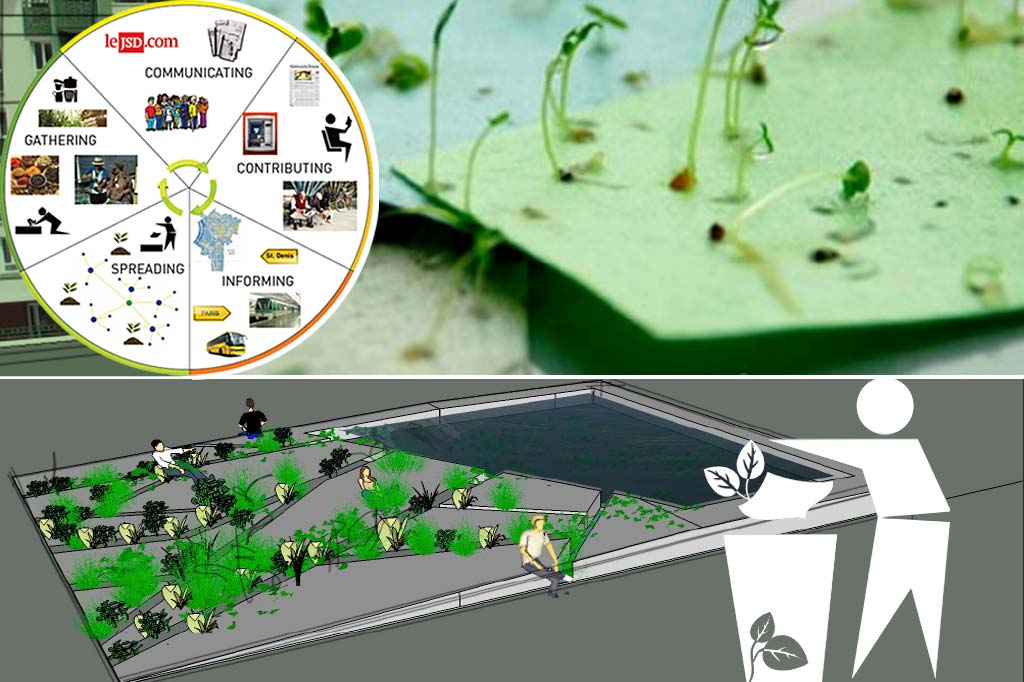 “Seine-Seed-Denis” by the Kunsthochschule, Linz, AUT
“Seine-Seed-Denis” by the Kunsthochschule, Linz, AUT
“The Green Rope” – Team Xiamen University Art College, China
Wang Kai, support in Xiamen: Zhu Mo
Design proposition:
Wang Kai represented the La Plaine area as “islands” of communities with no clear connection to their neighbours. He proposed to resolve this lack of cultural “connectivity” by using landscaping as the binding factor, and to “give up” certain streets to be used as green connecting passages. Thus he created the name Green Rope to describe his solution – a strong connecting force to unite the various cultural forces, and, at the same time, to “tame the beast” of isolation.
Wang Kai was particularly disturbed and “inspired” by his view of the present Chinese quarter – in his view, a closed and chaotic area and community, which in no way represents the “real” Chinese cultural connection to outside world. He therefore used the Chinese quartier as his “starting point” to design for each area a suitable landscape with elements which represent the local culture of its inhabitants.
For the Chinese quartier, he therefore designed an elevated walking path over the area, including a tea-house for refreshment and reflection. For Kai, this reflected the necessity to design into the solution the need to “rise over” chaotic daily business and provide more time for human connection amid the everyday rush.
In the same context, he also designed light solutions for the Chinese quarter – interactive, playful yet functional for security – which also project symbols as cultural expressions.
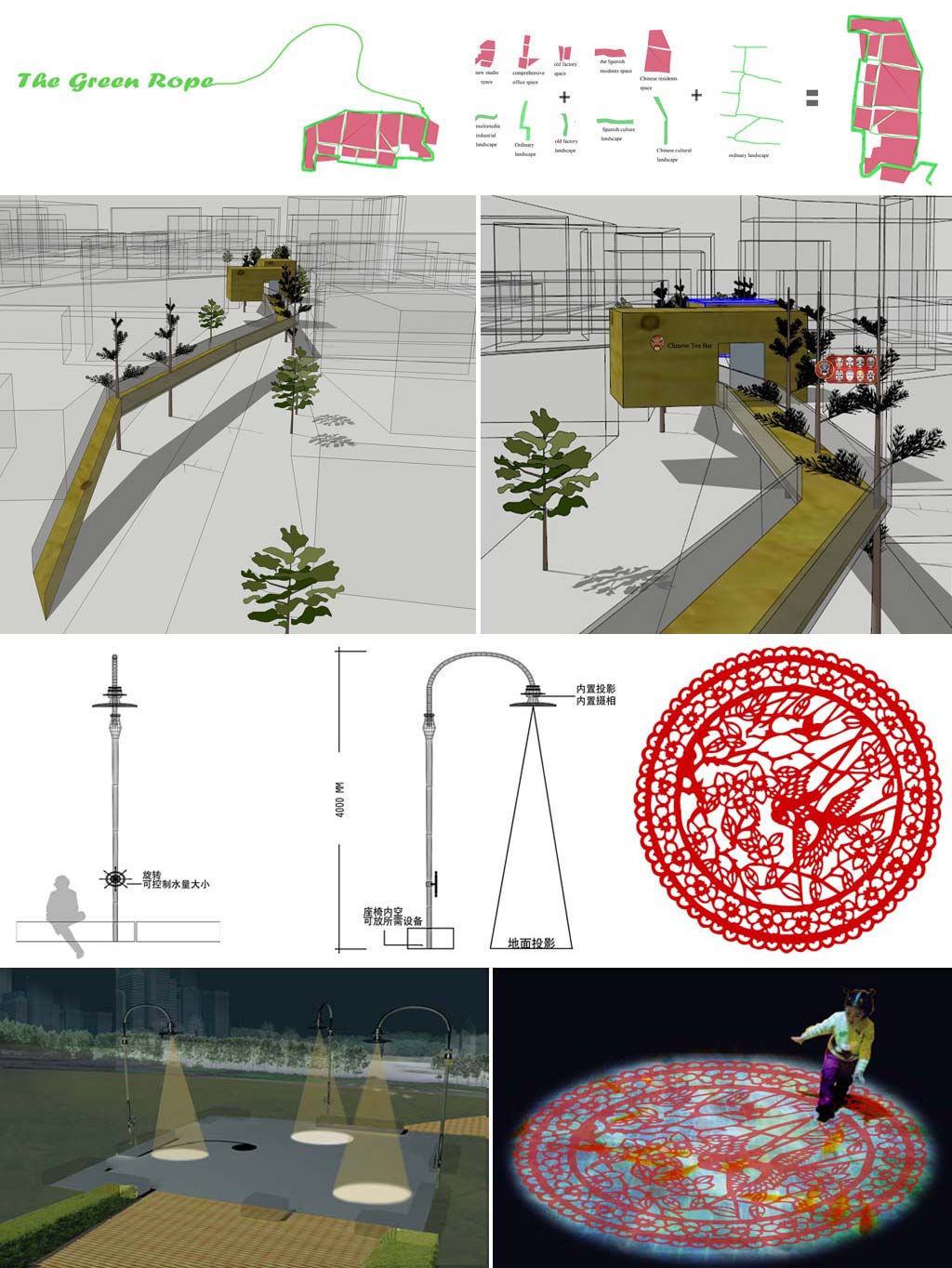 “The Green Rope” by Xiamen University Art College, Xiamen CN
“The Green Rope” by Xiamen University Art College, Xiamen CN
“Les Sentiers de La Plaine” – Team Ecole Boulle, Paris
Chloé Hueber, Laura Kiritze-Topor, Pauline Laufmolle, Arthur Richard, Fréderic Valentin
Design proposition:
The Boulle team noted emotions of “Emptiness, Disproportionate Scale, Boundaries, and Loss of Identity”. They therefore proposed a solution that would “Show the Existing Life, Develop an Intimate Scale, Connect the Local People, and Create a Visual Identity”. This would also give the members of the community an opportunity to “Leave my Imprint, Share my Messages, Meet my Neighbours, and Evolve our Identity”.
To this end, Team Boulle proposed a 4-Step solution:
- The Path – A path would be created to represent the main thoroughfares used by the members of the community in their daily lives, for example between the school, warehouses, metro station and port. This path would be created naturally by the inhabitants as their left their imprints on a surface of erasable gray paint, white flooring and tar which had been laid over the original covering.
- The Lights – A line of “fire-fly” lights – small LEDs – would follow the path. As these lights are also equipped with batteries and light sensors, they would light up naturally in the darkness, drawing people’s attention to messages left by other members of the community.
- The Messages – The Messages left by the community – for example drawing the attention of the inhabitants to a party for the “Fête des Voisins” – would be projected on the wall. Interaction with the projection is possible through motion tracking or a smart phone.
- The Events – The physical events – such as the party for the “Fête des Voisins” – are an excellent means to bring the various groups and cultures together in a traditional and natural way within the community.
This is, indeed, a very practical and innovative way to bring the whole community groups together in Saint-Denis La Plaine to celebrate their colourful diversity within a shared identity.
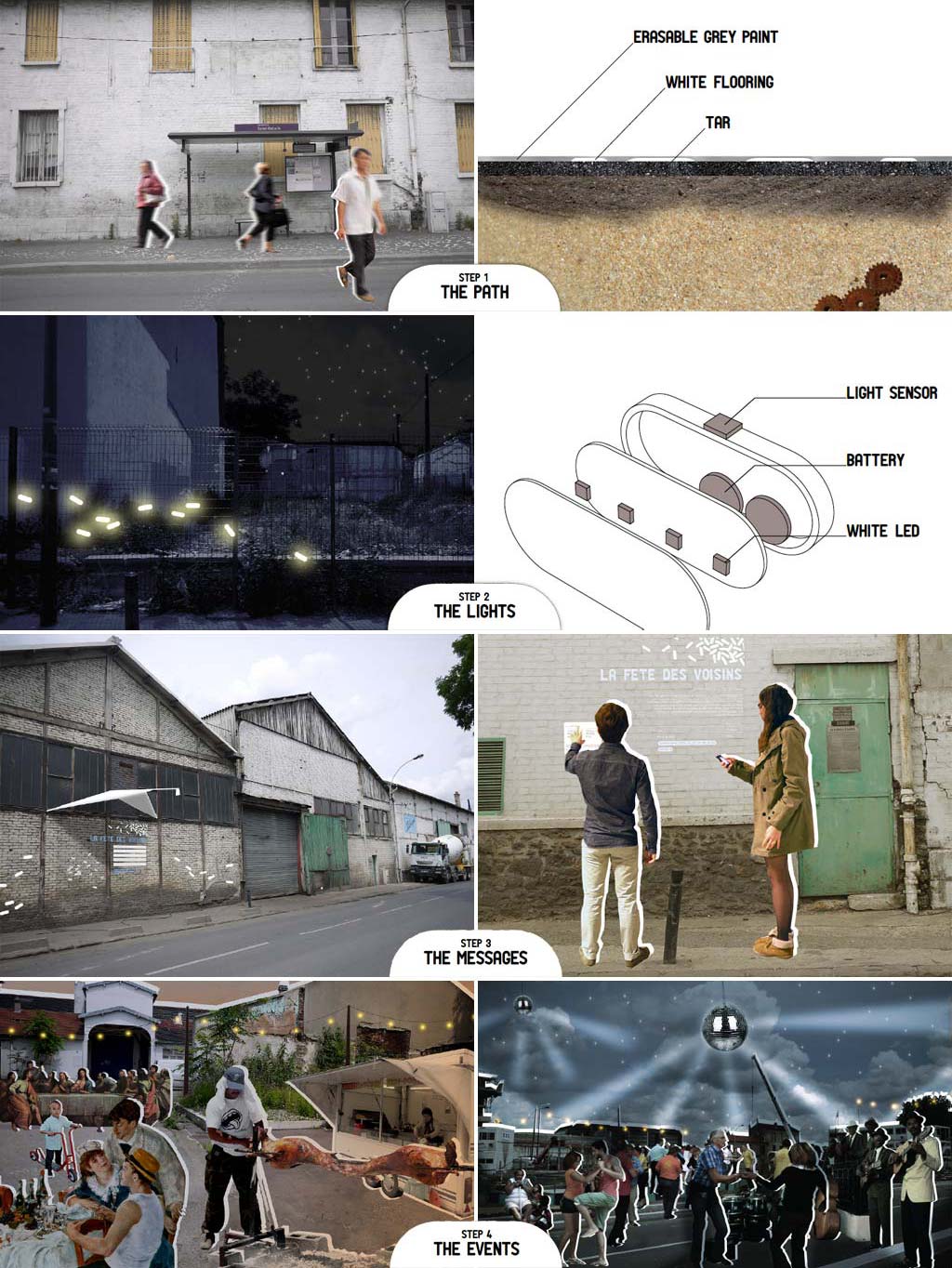 “Les Sentiers de La Plaine” by Ecole Boulle, Paris FR
“Les Sentiers de La Plaine” by Ecole Boulle, Paris FR
“Un, Deux, Trois, Soleil” – Team Ravensbourne, London
Afsaneh Afsari, Riccie Janus, Lidija Osmanovski, Eglantine Sicat
Design proposition:
The Ravensbourne team based their proposal on the belief that kids are the basis for bringing a community together in engaged and participative action for he future. In this context, they focused their proposal on the physical area at the centre of Condorcet – the future Place du Front Populaire. Within a green space on the square, they would design an installation: this would take the form of interactive “floors” on different levels, integrated into the base of trees. These floors contain interactive tiles. As children play on the floors, the tiles generate and store energy, which can be used, for example, directly to light up the trees above in the evening or indirectly, to feed energy into the whole community.
The significant advantages of such an installation are clear:
- Social Benefits: The solution is driven by “open data” and therefore scalable, and measurable. In addition, kids are made aware of technological benefits for the environment.
- Community Benefits: The Metro station, the connection for La Plaine to the city of Paris, is made a more attractive and inviting place. At the same time, local community identity and confidence are strengthened.
- End user benefits: A feeling of empowered ownership is created, new friendships are interactions arise, a safe kids’ playground and green breathing space are implanted in the neighbourhood.
- Service Quality: A meaningful and attractive recreational structure is created, with direct interaction with nature and technology.
- Content and Technology benefits: Open data and instant, flexible data visualization (JSON) are used. Effectiveness of communal transformation can be measured through use of real-time data.
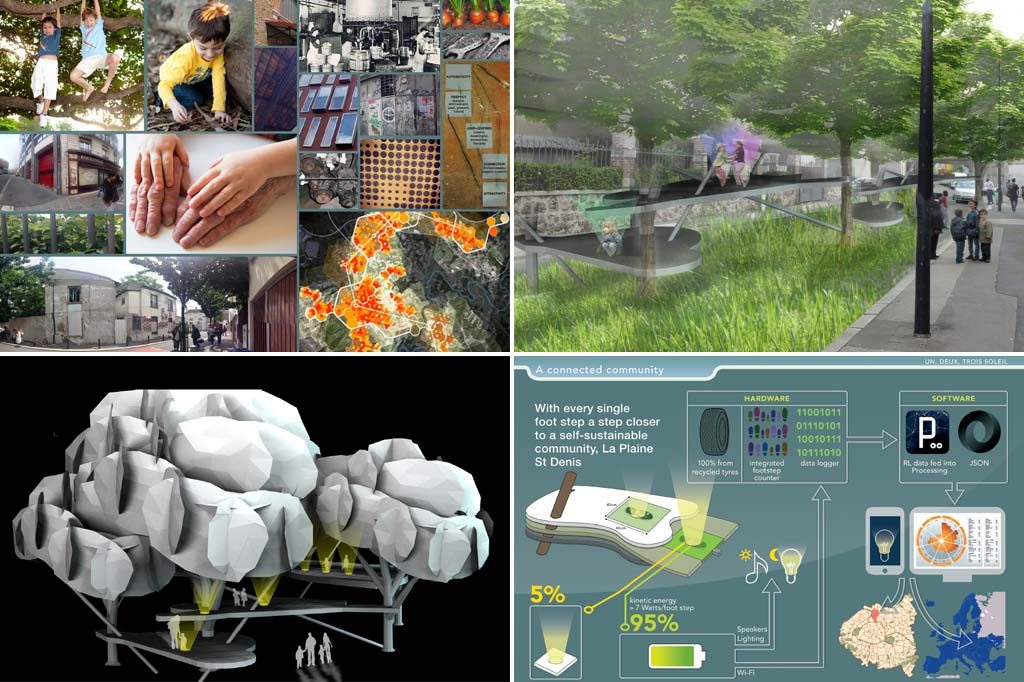 “Un, Deux, Trois, Soleil” by Ravensbourne, London UK
“Un, Deux, Trois, Soleil” by Ravensbourne, London UK
“Bouge Ton Quartier” – Team Young Professionals, Eindhoven, NL
Jorien Kemerink, Celine Malefijt, Jens Gijbels, Gordon Tiemstra
Design proposition:
The team noted that there was no clear official transportation infrastructure in the Condorcet area. However, at the same time, many private individuals in the quartier were obviously very busy throughout the day transporting their own goods. Means of transportation were obviously plentiful and available. The team therefore proposed an innovative means of providing transportation for others, which would also act as a means of community action, engagement and entrepreneurialism. The “Bouge Ton Quartier” community is an association of individuals from the quartier which offers transportation services for people and goods throughout the area. The means of transportation could be car, motor-bike or cycle, depending on the means and resources of the individuals concerned. There are special “Bouge Ton Quarter” signs which designate a pick-up place and which can also be displayed by community members when they are available for transportation services. A special smart phone app is also available to request the service.
This local transportation network could easily be linked into other such local networks, and the commercial potential – based initially around some form of points system instead of actual money – is quite evident.
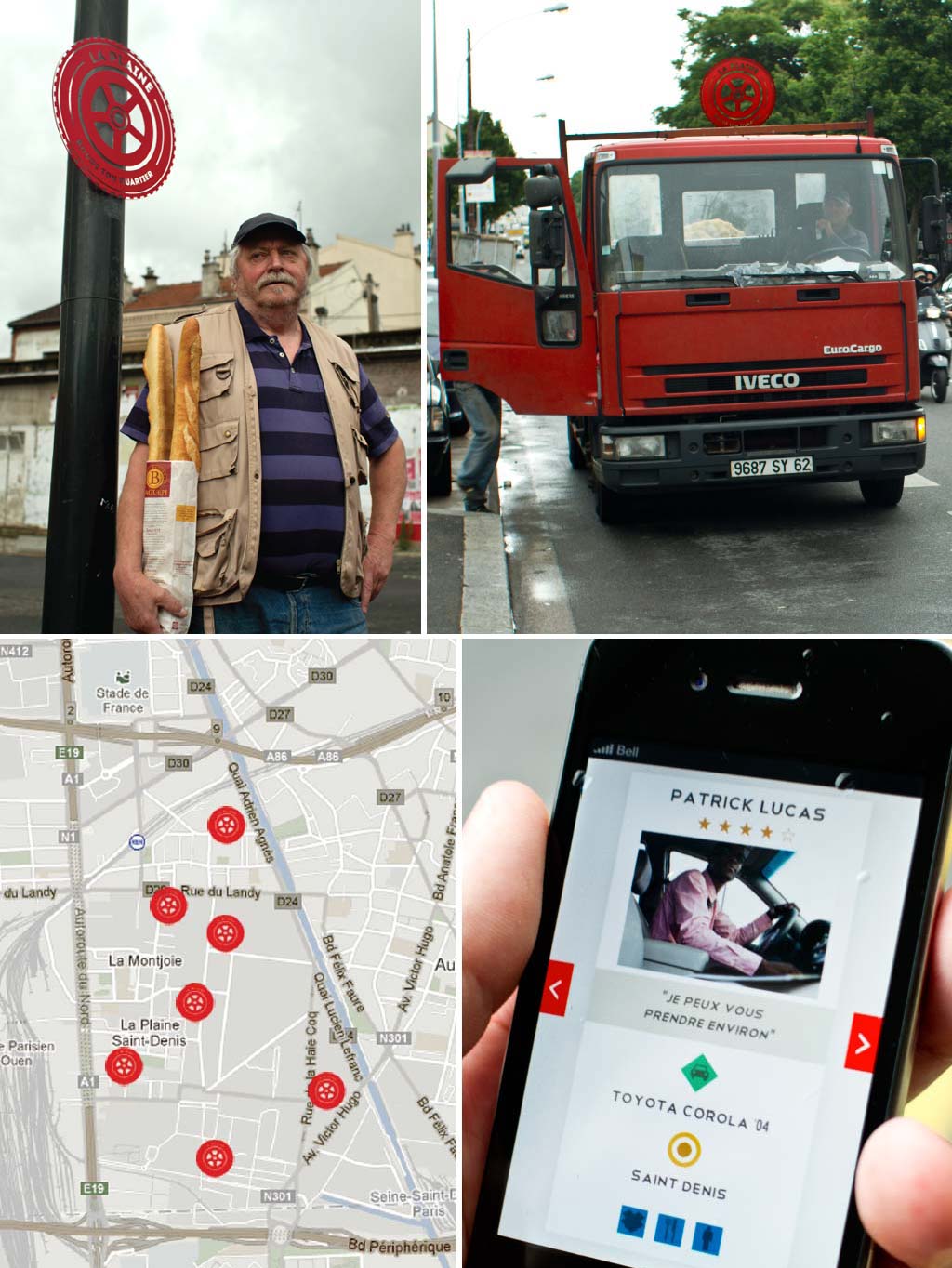 “Bouge Ton Quartier” by Team Young Professionals, Eindhoven NL
“Bouge Ton Quartier” by Team Young Professionals, Eindhoven NL
- Innovative
- Scalable
- Authentic
- Socially cohesive
- Feasible
2012 European Street Design Challenge Awards:
1st Prize: Prix du Conseil Général de Seine-Sant-Denis
Les Sentiers de la Plaine by Team Ecole Boulle
2nd Prize: Prix du Festival Futur en Seine
Bouge Ton Quartier by Team Young Designers Eindhoven
Prix de Jury
The Green Rope by Team University of Xiamen / Wang Kai
The awards were presented on behalf of the Conseil Général of Seine-Saint-Denis by Henri Verdier, President of Cap Digital.
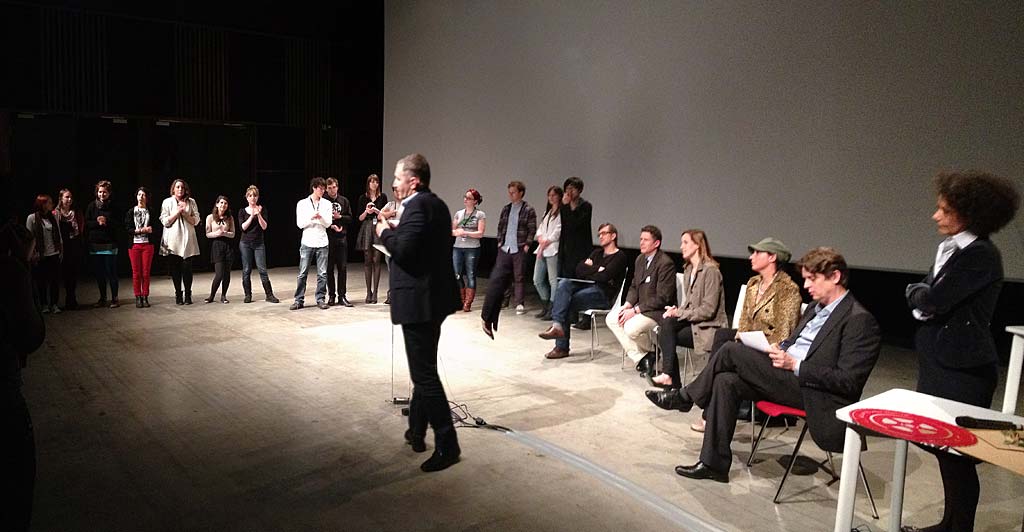 The jury announces the winners, runners-up and the Prix de Jury
The jury announces the winners, runners-up and the Prix de Jury

